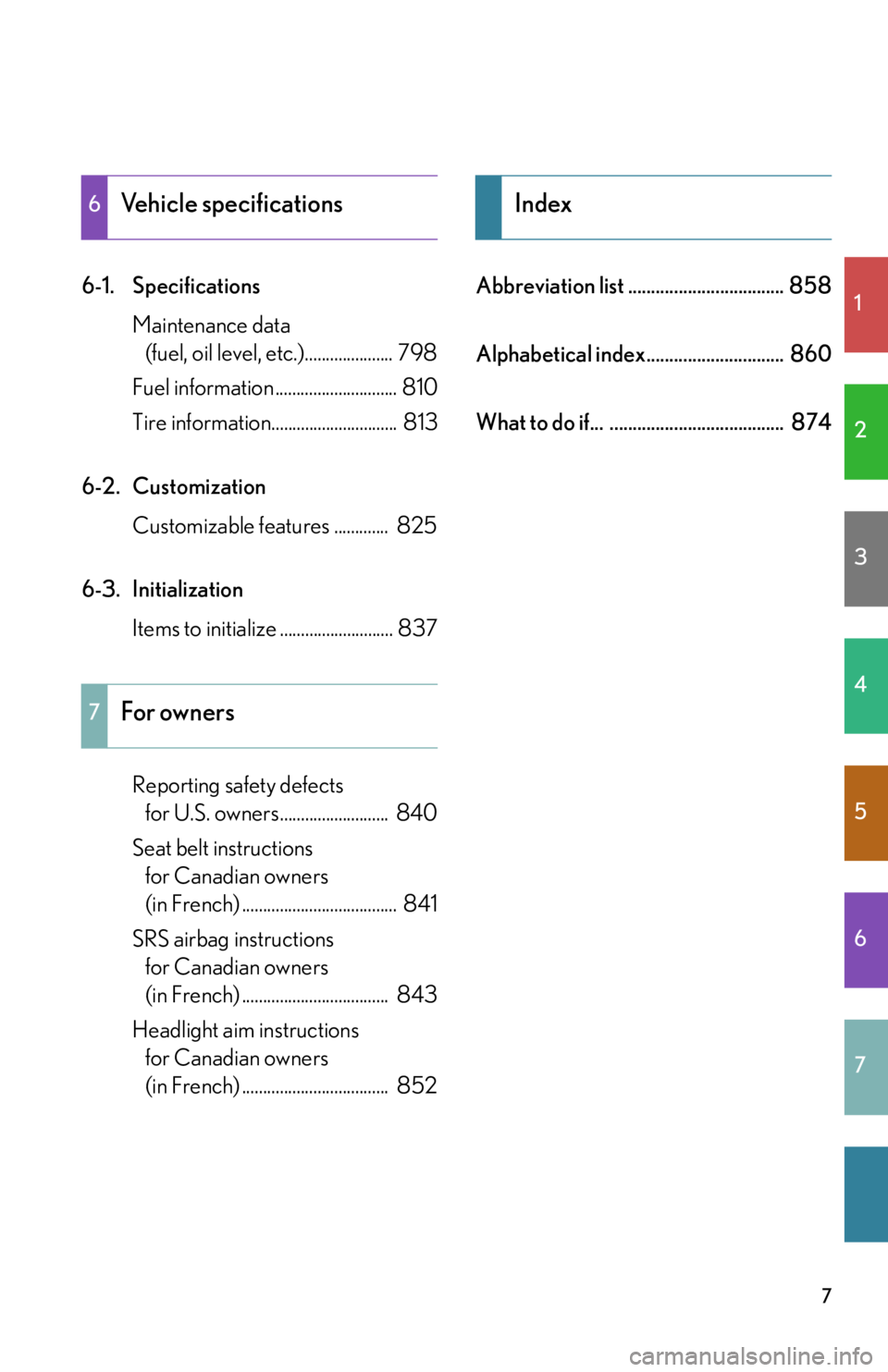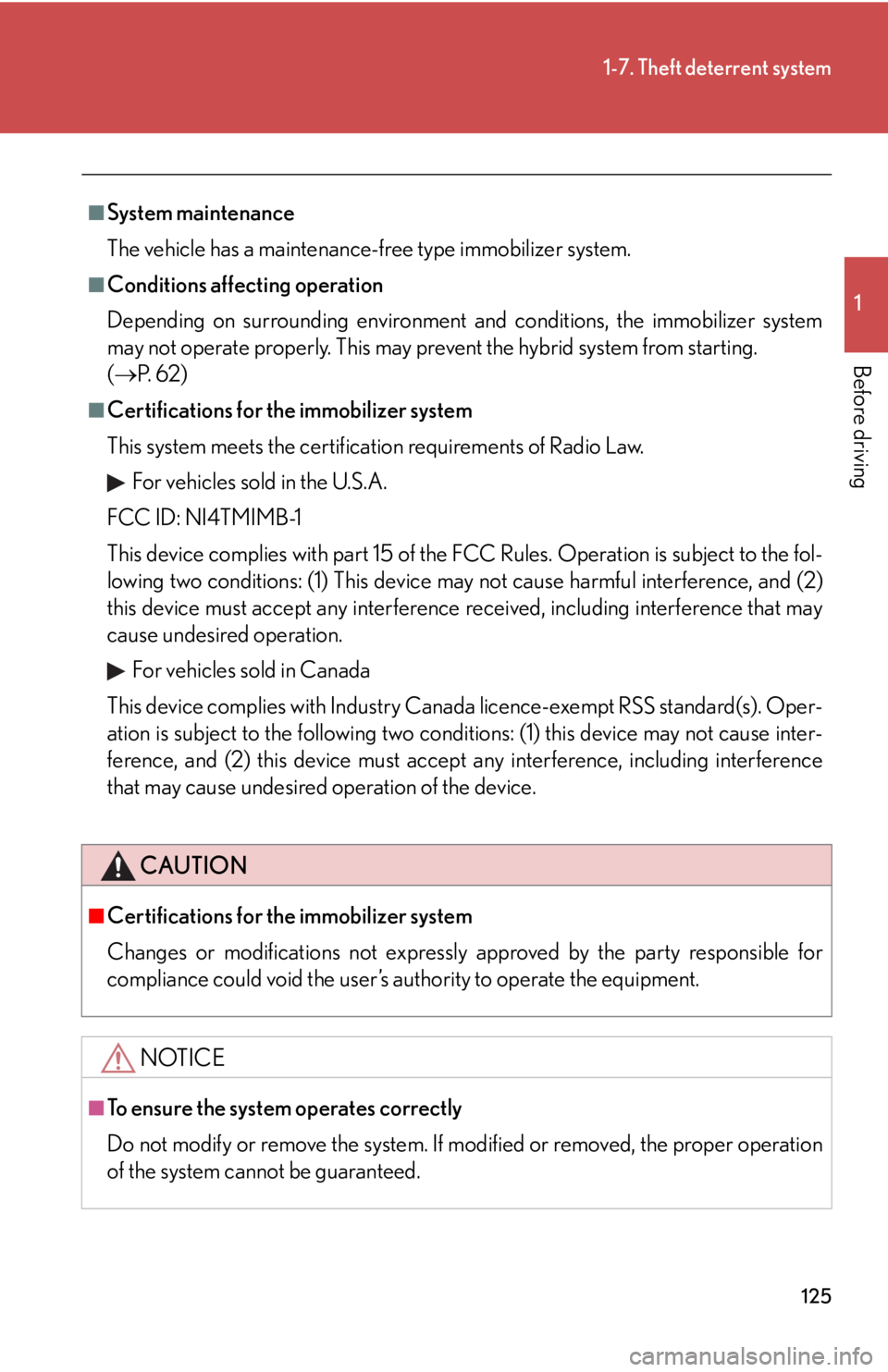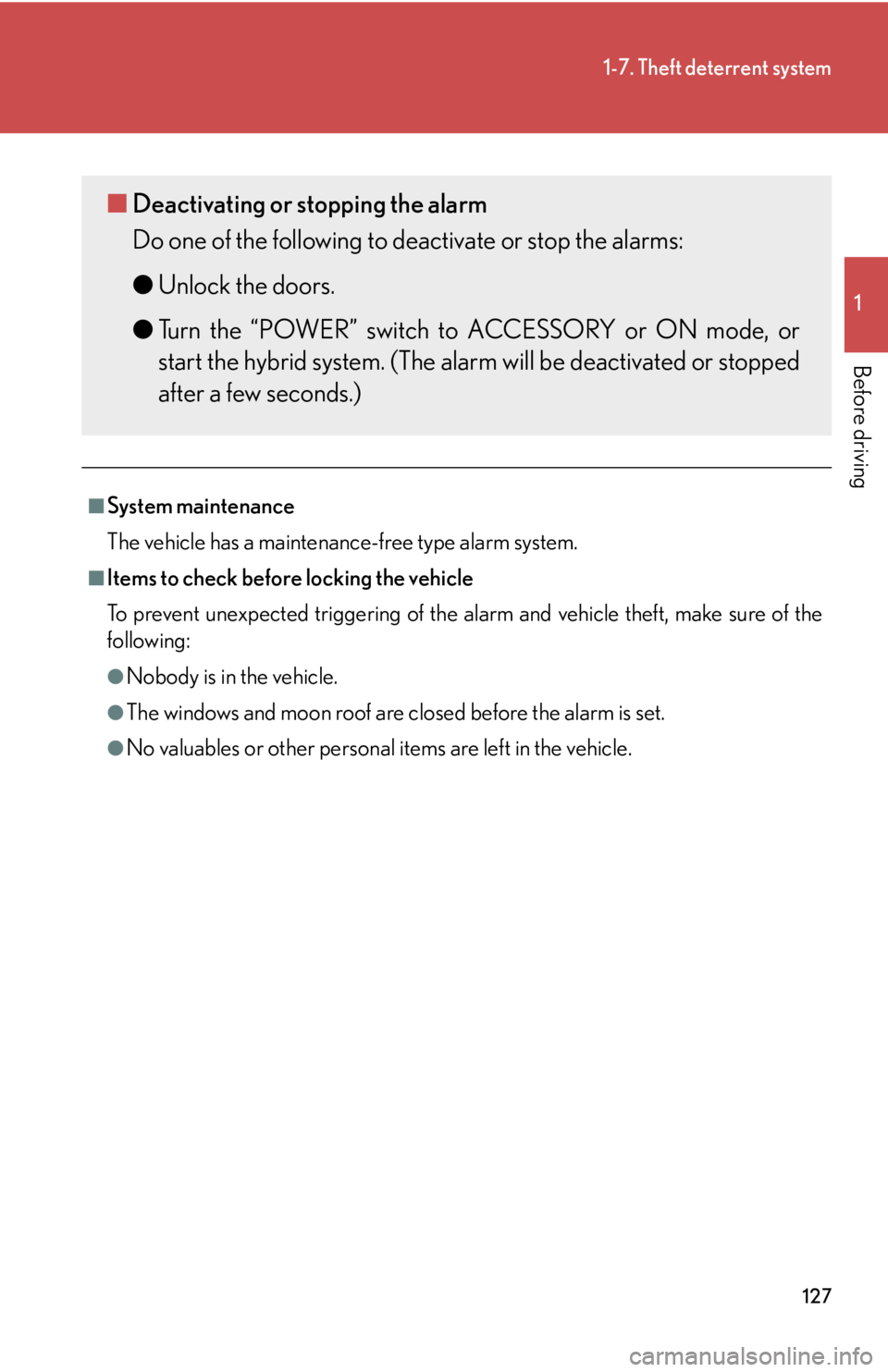2015 LEXUS RX450h maintenance
[x] Cancel search: maintenancePage 1 of 878

TABLE OF CONTENTS
11
Before driving Information on the hybrid syst em and adjusting and operat-
ing features such as door locks, mirrors, and steering col-
umn.
2
When driving Driving, stopping and safe-driving information.
3
Interior features Air conditioning and audio systems, as well as other interior
features for a comfortable driving experience.
4
Maintenance
and care Cleaning and protecting your vehicle, performing do-it-your-
self maintenance, and maintenance information.
5
When trouble
arises What to do if the vehicle needs to be towed, gets a flat tire,
or is involved in an accident.
6
Vehicle
specifications Detailed vehicle information.
7
For owners Reporting safety defects for U.S. owners, and seat belt, SRS
airbag and headlight aim instru ctions for Canadian owners.
Index Alphabetical listing of informat ion contained in this manual.
Page 6 of 878

TABLE OF CONTENTS Index
64-1. Maintenance and care
Cleaning and protecting
the vehicle exterior................... 634
Cleaning and protecting
the vehicle interior .................... 637
4-2. Maintenance
Maintenance requirements .... 640
General maintenance ................ 643
Emission inspection and
maintenance (I/M)
programs ...................................... 647
4-3. Do-it-yourself maintenance
Do-it-yourself service
precautions ................................. 648
Hood................................................... 651
Positioning a floor jack............... 652
Engine compartment.................. 654
12-volt battery................................ 664
Tires ................................................... 670
Tire inflation pressure ................. 679
Wheels............................................. 683
Air conditioning filter ................. 685
Electronic key battery ................ 687
Checking and replacing
fuses ............................................... 689
Headlight aim................................. 705
Light bulbs ...................................... 708 5-1. Essential information
Emergency flashers..................... 724
If your vehicle needs to be
towed.............................................. 725
If you think something is
wrong ............................................. 732
5-2. Steps to take in an emergency
If a warning light turns on
or a warning buzzer
sounds... ........................................ 733
If a warning message is
displayed ....................................... 743
If you have a flat tire..................... 764
If the hybrid system will not
start ................................................. 777
If the shift lever cannot be
shifted from P .............................. 779
If you lose your keys ................... 780
If the electronic key does
not operate properly ................ 781
If the vehicle 12-volt battery
is discharged ............................... 784
If your vehicle overheats .......... 788
If the vehicle becomes
stuck................................................ 793
If your vehicle has to be
stopped in an em ergency ...... 7954
Maintenance and care 5
When trouble arises
Page 7 of 878

1
2
3
4
5
6
7
76-1. Specifications
Maintenance data
(fuel, oil level, etc.)..................... 798
Fuel information ............................. 810
Tire information.............................. 813
6-2. Customization
Customizable features ............. 825
6-3. Initialization
Items to initialize ........................... 837
Reporting safety defects
for U.S. owners.......................... 840
Seat belt instructions
for Canadian owners
(in French) ..................................... 841
SRS airbag instructions
for Canadian owners
(in French) ................................... 843
Headlight aim instructions
for Canadian owners
(in French) ................................... 852 Abbreviation list .................................. 858
Alphabetical index.............................. 860
What to do if... ...................................... 8746
Vehicle specifications
7
For owners Index
Page 33 of 878

331-1. Hybrid system
1
Before driving ■
Sounds and vibrations specific to a hybrid vehicle
There may be no engine sounds or vibration even though the vehicle is able to
move. Always shift the shift lever to P when parked.
The following sounds or vibrations may o ccur when the hybrid system is operating,
and are not a malfunction: ●
Motor sounds may be heard fr om the engine compartment.●
Sounds may be heard from the hybrid battery (traction battery) under the rear
seat when the hybrid system starts or stops.●
Sounds from the hybrid system may be heard when the back door is open.●
Sounds may be heard from the hybrid transmission when the engine is started
or stopped, or while the engine is idling.●
Engine sounds may be heard when accelerating sharply.●
Sounds may be heard due to regenerative braking when the brake pedal is
depressed and accelerator is loosened.●
Vibration may be felt when the gasoline engine starts or stops.●
Cooling fan sounds may be heard from th e air intake vents un der the rear seat.■
Vehicle Proximity Notification System
In the following cases, the Vehicle Proximit y Notification System sound may be diffi-
cult for pedestrians, people riding bicycles or other peop le and vehicles in the sur-
rounding area to hear: ●
When there is a lot of noise in the vicinity ●
When it is raining or during strong winds●
When in the area surrounding the rear of the vehicle, rather than in front of the
vehicle■
Maintenance, repair, recycling, and disposal
Contact your Lexus dealer regarding main tenance, repair, recycling and disposal.
Do not dispose of the vehicle yourself.
Page 125 of 878

1251-7. Theft deterrent system
1
Before driving ■
System maintenance
The vehicle has a maintenance-free type immobilizer system.■
Conditions affecting operation
Depending on surrounding environment and conditions, the immobilizer system
may not operate properly. This may prevent the hybrid system from starting.
( P. 6 2 )■
Certifications for the immobilizer system
This system meets the certification requirements of Radio Law.
For vehicles sold in the U.S.A.
FCC ID: NI4TMIMB-1
This device complies with part 15 of the FCC Rules. Operation is subject to the fol-
lowing two conditions: (1) This device may not cause harmful interference, and (2)
this device must accept any interference received, including interference that may
cause undesired operation.
For vehicles sold in Canada
This device complies with Industry Cana da licence-exempt RSS standard(s). Oper-
ation is subject to the following two conditions: (1) this device may not cause inter-
ference, and (2) this device must accept any interference, including interference
that may cause undesired operation of the device.
CAUTION■
Certifications for the immobilizer system
Changes or modifications not expressly approved by the party responsible for
compliance could void the user’s authority to operate the equipment.
NOTICE
■
To ensure the system operates correctly
Do not modify or remove the system. If mo dified or removed, the proper operation
of the system cannot be guaranteed.
Page 127 of 878

1271-7. Theft deterrent system
1
Before driving ■
System maintenance
The vehicle has a maintenance-free type alarm system.■
Items to check before locking the vehicle
To prevent unexpected triggering of the alarm and vehicle theft, make sure of the
following: ●
Nobody is in the vehicle.●
The windows and moon roof are closed before the alarm is set.●
No valuables or other personal items are left in the vehicle.■ Deactivating or stopping the alarm
Do one of the following to deactivate or stop the alarms:
● Unlock the doors.
● Turn the “POWER” switch to ACCESSORY or ON mode, or
start the hybrid system. (The alarm will be deactivated or stopped
after a few seconds.)
Page 295 of 878

2952-5. Driving information
2
When driving NOTICE■
To prevent water damage
Take all necessary safety measures to ensure that water damage to the hybrid bat-
tery, hybrid system or other components does not occur. ●
Water entering the engine compartment may cause severe damage to the hybrid
system. Water entering the interior may cause the hybrid battery stowed under
the rear seats to short circuit.●
Water entering the hybrid transmission will cause deterioration in transmission
quality. The malfunction indicator may come on, and the vehicle may not be driv-
able.●
Water can wash the grease from wheel bearings, causing rusting and premature
failure, and may also enter the hybrid transmission case, reducing the gear oil’s
lubricating qualities.■
When you drive through water
If driving through water, such as when crossing shallow streams, first check the
depth of the water and the bottom of the riverbed for firmness. Drive slowly and
avoid deep water.■
Inspection after off-road driving ●
Sand and mud that has accumulated around brake discs may affect braking effi-
ciency and may damage brake system components.●
Always perform a maintenance inspection after each day of off-road driving that
has taken you through rough terrain, sand, mud, or water. For scheduled mainte-
nance information, refer to the “Warra nty and Services Guide/Owner’s Manual
Supplement/Schedul ed Maintenance”.
Page 320 of 878

3202-5. Driving information
■
Break-in schedule
If your vehicle is new or equipped with any new power train components (such as
an engine, transmission, differential or wheel bearing), Lexus recommends that you
do not tow a trailer until the vehicle has been driven for over 500 miles (800 km).
After the vehicle has been driven for over 500 miles (800 km), you can start tow-
ing. However, for the next 500 miles (800 km), drive the vehicle at a speed of less
than 50 mph (80 km/h) when towing a trailer, and avoid full throttle acceleration.■
Maintenance ●
If you tow a trailer, your vehicle will require more frequent maintenance due to
the additional load. (See “Warranty and Services Guide”, “Owner's Manual
Supplement” or “Scheduled Maintenance”.)●
Retighten the fixing bolts of the towing ball and bracket after approximately
600 miles (1000 km) of trailer towing.■
If trailer sway occurs
One or more factors (crosswinds, passing vehicles, rough roads, etc.) can adversely
affect handling of your vehicle and trailer, causing instability. ●
If trailer swaying occurs:
• Firmly grip the steering wheel. Steer straight ahead.
Do not try to control trailer sway ing by turning the steering wheel.
• Begin releasing the accelerator peda l immediately but very gradually to
reduce speed.
Do not increase speed. Do not apply vehicle brakes.
If you make no extreme correction with the steering or brakes, your vehicle and
trailer should stabilize. ●
After the trailer swaying has stopped:
• Stop in a safe place. Get all occupants out of the vehicle.
• Check the tires of the vehicle and the trailer.
• Check the load in the trailer.
Make sure the load has not shifted.
Make sure the tongue weight is appropriate, if possible.
• Check the load in the vehicle.
Make sure the vehicle is not ov erloaded after occupants get in.
If you cannot find any problems, the speed at which trailer swaying occurred is
beyond the limit of your particular vehicle-trailer combination.
Drive at a lower speed to prevent instability. Remember that swaying of the towing
vehicle-trailer increases as speed increases.